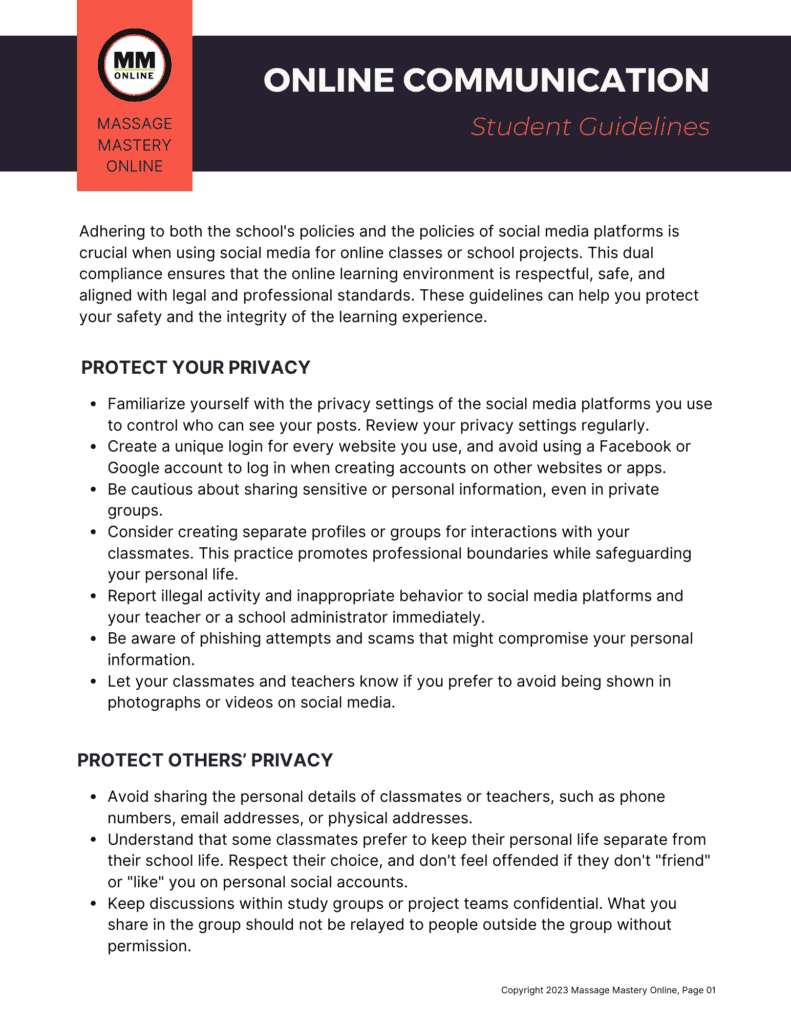If your students use social media platforms for coursework, peer discussion, or projects, you’ll want to provide clear guidelines for engaging with peers safely and professionally. We did a deep dive into best practices for guiding students and developed this handout. Download the handout, print it, and distribute it to students as it is, or use it as a model to develop your own guidelines. We’ve outline the guidelines here in the event you wish to share them with students in a digital format by linking students to this webpage.

Guidelines for Online Communication
Adhering to both the school’s policies and the policies of social media platforms is crucial when using social media for online classes or school projects. This dual compliance ensures that the online learning environment is respectful, safe, and aligned with legal and professional standards. These guidelines can help you protect your safety and the integrity of the learning experience.

Protect Your Privacy
- Familiarize yourself with the privacy settings of the social media platforms you use to control who can see your posts. Review your privacy settings regularly.
- Create a unique login for every website you use, and avoid using a Facebook or Google account to log in when creating accounts on other websites or apps.
- Be cautious about sharing sensitive or personal information, even in private groups.
- Consider creating separate profiles or groups for interactions with your classmates. This practice promotes professional boundaries while safeguarding your personal life.
- Report illegal activity and inappropriate behavior to social media platforms and your teacher or a school administrator immediately.
- Be aware of phishing attempts and scams that might compromise your personal information.
- Let your classmates and teachers know if you prefer to avoid being shown in photographs or videos on social media.
Protect Others’ Privacy
- Avoid sharing the personal details of classmates or teachers, such as phone numbers, email addresses, or physical addresses.
- Understand that some classmates prefer to keep their personal life separate from their school life. Respect their choice, and don’t feel offended if they don’t “friend” or “like” you on personal social accounts.
- Keep discussions within study groups or project teams confidential. What you share in the group should not be relayed to people outside the group without permission.
- Always get consent from everyone involved before taking and sharing photos, videos, or audio recordings. Be cautious when sharing classroom screenshots or images if they contain classmates’ names, faces, or other identifying information.

Recognize Slander, Harassment, and Bullying
- If you have an issue with the school, an administrator, a teacher, or a classmate, don’t post about it on social media. Instead, set up a private meeting to discuss your concerns or ask to meet with the involved parties and a counselor or facilitator.
- Slander, harassment, and bullying have academic and legal consequences. For example, you may be expelled from school, sued for damages in a civil court, and banned from social media platforms.
- Slander involves making false and damaging statements about someone. In the context of social media, this can include posting untrue statements that harm a person’s reputation.
- Harassment on social media includes unwanted and persistent behavior that creates an intimidating, hostile, or offensive environment, including sending someone direct messages or posting on their personal pages after they have asked you to stop.
- Bullying on social media includes aggressive behavior intended to intimidate or harm someone else. It manifests as hurtful comments, spreading rumors, or posting personal information without consent.
- If you see posts from classmates that are slanderous, harassing, or bullying, document the posts by taking a screenshot or saving a direct message or email as evidence.
- All social media platforms have mechanisms for reporting inappropriate interactions and posts. Know these mechanisms so you can report abuses immediately.
- Inform school authorities and share evidence if the abuse happens between classmates and teachers. Report slander, harassment, and bullying immediately.
- In severe cases, it may be necessary to involve law enforcement, particularly if there are threats of violence or persistent harassment.
- In cases of serious slander or harassment, you may wish to seek legal advice to understand your options.
Communicate Constructively and Professionally
- Work with teachers and classmates to establish and agree upon guidelines for communication on social media. Discuss the use of appropriate language, response times, and teacher availability. For instance, teachers might specify their available hours for immediate responses.
- Avoid swear and slang words and communicate in complete sentences whenever possible.
- Avoid the use of emojis in the place of written communication. Many emojis have different meanings depending on the context and may cause offense.
- Appropriate visual aids like images, videos, or diagrams enhance posts and clarify complex ideas. Don’t post media featuring teachers or classmates without their consent or share other people’s work without giving them credit.
- Ensure that multimedia is accessible to all classmates, including those with disabilities. Provide image descriptions and use subtitles or closed captions on videos.
- Keep the focus of conversations or posts on course-related topics.
- Phrases that encourage and support can foster a positive atmosphere. For example, saying, “I appreciated your insight on X” or “Your post made me think about Y” can feel encouraging.
- Be sensitive to cultural differences and strive to avoid assumptions based on your own cultural background.
- When offering criticism, frame it constructively by focusing on the ideas rather than the person. For example, “Have you considered looking at it from this perspective?” instead of “You’re wrong about X.”
- In online communication, it’s crucial to thoroughly read or listen to what others are saying before responding to ensure your comments are relevant and considered.
- If a point isn’t clear, ask clarifying questions to demonstrate your engagement and to avoid misunderstandings.
- Encourage respectful debate rather than confrontational argument. Acknowledge the good points made by others before presenting counterpoints.
- If a discussion becomes heated, suggest continuing the conversation later or in a more private setting. Ranting usually leads to negative consequences, as people share unkind or inflammatory posts across the Internet. Even if you delete the post, its digital footprint persists.
- Social media makes it easy to share things from behind a screen that you wouldn’t feel comfortable saying in real life. If you wouldn’t say it to someone’s face, don’t say it on social media.
- Be open to receiving feedback about your posts and communication style. Regularly reflect on your interactions and consider whether they contribute positively to the learning environment.

Avoid the Spread of Misinformation
- False and misleading information is prevalent on social media. It can range from innocent inaccuracies to deliberately deceptive “fake news.”
- Reliance on misinformation can lead to flawed understanding, inaccurate coursework, and misguided discussions in educational contexts.
- Search engines filter search results based on a user’s previous activity. This “filtered bubble effect” skews the information people receive, promoting faulty assumptions and misinformation. Use different search engines, the incognito function on your browser, or anonymous search engines like DuckDuckGo or Startpage, which do not track user data or search history.
- Approach sensational or controversial claims or information with skepticism. Analyze the source of the information and evaluate the potential biases of the source.
- Use fact-checking websites like Snopes, FactCheck.org, and others to identify online misinformation.
- Evaluate the credibility of a source by looking at the author’s credentials, the outlet’s reputation, and the publication date. You want to base the information you share on recent advances and research.
- Check the information you wish to post against multiple sources. If a piece of information is accurate, it is likely to be reported by multiple credible sources.
- Report “fake news” and misleading information to the relevant social media platform and your instructor.
Demonstrate Academic Integrity
- Maintaining academic integrity while using social media for coursework and peer interactions involves honesty, understanding plagiarism, respecting intellectual property, and adhering to privacy and confidentiality policies.
- In online discussions, contribute genuine thoughts and ideas. If you refer to someone else’s ideas, give them credit.
- Avoid misrepresenting yourself or your achievements. Be truthful about your background and qualifications.
- Plagiarism online includes copying others’ writing or posts, using someone else’s ideas without proper attribution, or sharing answers to assignments with classmates.
- Ensure the content you create and share is original. Acknowledge others’ work with proper references or links.
- Intellectual property refers to creations of the mind for which authorities recognize exclusive rights. Under intellectual property law, owners have exclusive rights to their original creations. This includes protections (copyright) for authoring books, articles, music, film, paintings, and software and patents to protect inventions and discoveries.
- Trademarks are the protected symbols, names, and slogans used to identify and distinguish goods and services. Registered trademarks are protected under intellectual property laws.
- Respect intellectual property rights by citing the original source of the writing, music, video, or images you use on social media or for school projects.
- Be cautious about sharing copyrighted materials such as articles, images, videos, or music without permission.


